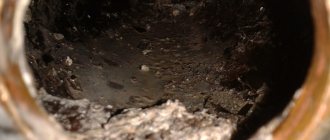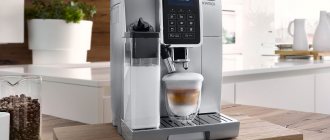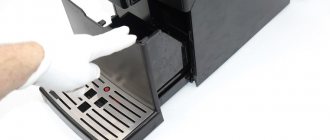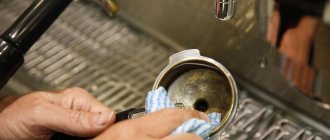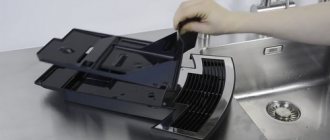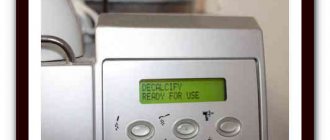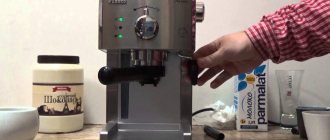A coffee machine or coffee maker is popular among coffee lovers. It allows you to quickly prepare delicious and aromatic coffee, so valued by lovers of this drink.
However, like any other equipment, it requires compliance with operating rules and timely maintenance.
Immediately after purchasing a coffee machine, you should carefully study the instructions, so that later you do not have to be surprised by the taste of the prepared coffee deteriorating over and over again, or even worse, spend money on expensive repairs.
Therefore, it is important to know how the process of preparing coffee in a coffee machine occurs and what must be observed to maintain its unique quality.
How does a coffee machine work?
This technique, like its cheaper analogue - a coffee maker, automates the stages of preparing tasty and aromatic coffee.
When using it, it is possible to avoid many manual errors in the kitchen, among which burnt grains and incorrect dosage are the most common. The operation of the coffee machine can be divided into two successive stages:
- making classic espresso coffee;
- production of varieties of coffee drinks.
First stage
Depending on the model of the device, a person needs to carry out certain preparatory work:
- the coffee machine will do almost everything itself, it only requires a person to pour coffee beans into a special hopper and the presence of water in the tank;
- a coffee maker will require much more human action, including separate grinding of the beans and tamping them in a filter, or the use of special packages of ground coffee in filter bags called “pods.”
The device, based on a programmed program, heats up a portion of water under a certain pressure in a special tank and passes it through ground beans, extracting beneficial substances for the drink - espresso coffee without harmful resins and unnecessary components.
Changing the dose of boiling water allows you to get a drink of different degrees of strength.
Some coffee lovers limit themselves to this stage, choosing classic espresso. However, most coffee lovers prepare its varieties: cappuccino, latte, Americano, lungo, macchiato and others.
The second stage is getting your favorite brand of coffee
Its essence comes down to adding additives in the form of milk, milk foam or hot water from the machine automatically or with human participation in certain proportions to the espresso prepared at the first stage. It all depends on the model of the device.
You can also add syrup, honey, chocolate, spirits and other ingredients to create coffee drinks that cannot be created entirely using the capabilities of a coffee machine. This is how your favorite brand of coffee is created.
During technological processes, coffee oils accumulate inside the coffee machine, which transfer unpleasant odors and bitterness to the newly prepared drink, and scale is released from the water. All these impurities must be carefully removed. To do this, maintenance is carried out related to flushing and cleaning of internal lines.
When performing these works, you should realize that not only they affect the quality of the prepared drink.
What determines the taste of coffee?
The quality of the prepared drink depends on many different reasons. They all need to be known and taken into account, otherwise coffee prepared at home may not live up to our expectations.
The main factors influencing the taste of the drink include:
- selected varietal mixture of coffee beans;
- method of storing coffee;
- degree of grinding of grains;
- quality of water and milk;
- absence of unpleasant odors in the kitchen;
- the operating program set for the coffee machine or coffee maker.
Even a person acting as a barista can influence the taste of coffee when using technology.
What is decalcification of a coffee machine
Drinking water always contains a certain amount of calcium salts. There are more of them in hard water, less in soft water, but in any case they are present. During the operation of the coffee machine, these salts are gradually deposited on its various elements in contact with the aquatic environment, and over time they form plaque (scale). Because of this hardened deposit, the machine begins to work worse, and the coffee develops an off-flavor. There is only one way out of the described situation - cleaning the coffee machine from accumulated deposits, also known as decalcification.
The higher the water hardness, the more deposits will form in the coffee machine, and the more often you will have to clean it. In some cases you have to do this monthly. Therefore, it is best to use soft bottled water to make coffee; it also has a positive effect on the taste of this drink.
Table-review of purchased decalcification products
There are many products on sale that remove scale from various types of coffee machines. For ease of comparison, the characteristics of some common tools are summarized in a general table.
| Name | Type | Peculiarities | Package volume |
| Top house | Liquid or tablets | Manufactured taking into account the recommendations of manufacturers, made in Germany | 0.25 liters of liquid for two uses or 8 tablets per pack for 8 uses |
| Topper 3006 | Liquid | Manufactured taking into account the recommendations of manufacturers, made in Germany | 0.25 l for two uses |
| DeLonghi DLSC500 | Liquid | Optimized for DeLonghi equipment, but also suitable for other brands, made in Italy | 0.5 l for 4 uses |
| Philips-Saeco CA6700/00 | Liquid | It has a soft action, protects against corrosion, made in Germany | 0.25 l for one cleaning cycle |
| Melitta | Liquid or powder | Features a mild action, made in Germany | 0.25 l liquid for five cleanings or 2 sachets for two uses |
| Bosch TCZ8002 | Pills | Instant tablets, made in Germany | The package contains three tablets for three uses |
| Filtero | Pills | Instant tablets, made in Germany | Pack contains 4 tablets for four uses |
Top House
Topper 3006
DeLonghi DLSC500
Philips-Saeco CA6700/00
Melitta
Bosch TCZ8002
Filtero
Cleaning using special means: step-by-step summary
The manufacturer includes a care instructions for each coffee machine. The owner of this technique just has to purchase the right product, and then accurately perform all the operations, step by step.
Important note: the product should be stored in a place that is difficult for children to reach.
If a problem does happen to you or your children and the product gets on your skin or, even worse, in your eyes, urgent rinsing with water will help.
For machines with automatic descaling
Here are your actions step by step:
- pour the decalcifier (the product you received to descale the coffee machine) into the water tank;
- pour water into it, not boiling water, but quite hot (approximately 0.8 l);
- press the start button;
- Pour the first two cups (in addition to water, they will also contain a cleaning product) through a tube through which boiling water is supplied;
- use the lever to turn off the hot water supply;
- prepare a few more cups of “conventional coffee”, pour them out again;
- then connect an automatic program to work, which should finish the fight against scale you started;
- Remove from the coffee machine and wash the removable device under running water.
The recipe for making Kalmyk tea is carefully discussed in this publication.
And in this article we will talk about coffee makers for ground coffee for home.
No automatic deletion
Oh, this is what you need to do if your machine does not have an automatic descaling program:
- pour decalcifier and heated water into the water container;
- press the start button;
- drain two cups of water through the tube;
- repeat the function more than 5 times, and more if you feel the need;
- turn off the hot water supply lever;
- prepare two or three cups of “conditional coffee” by adding a cleansing product to the water;
- perform the operation a couple of times: there should be no more traces of the cleaning agent left in the car;
- remove the removable device from the coffee machine and wash it well, and then return it to its place.
Descaling the Delonghi ECAM 23.210 coffee machine
We told you how and with what means you need to descale your coffee machine.
But it is very important that the care of the equipment is comprehensive: the holder must be frequently cleaned of coffee deposits (using water and a lip, without any detergents), the remains of ground coffee must be removed from the brewing unit, and milk must be removed from the cappuccino maker.
If you take care of your car carefully and often, it will serve you for a very long time.
Did you like the article? Share it with your friends:
How to descale a drip coffee maker?
Is decalcification necessary?
Over time, almost a crust of limescale forms on the walls, and lime quickly corrodes everything: metal parts, and even more so, fragile plastic. But this will take a long time, but the water will quickly become tasteless, and moreover, harmful, since microorganisms and bacteria actively multiply in the porous structure of the plaque, and boiling does not kill them.
Signs that it's time to descale:
- Steam pressure has decreased;
- The coffee seems under-brewed;
- The drink has a musty smell and taste;
- The stream of pouring coffee became thinner;
- The sound of the coffee machine running became louder.
Some coffee machines are equipped with an automatic reminder that it is time to descale. This could be a message or just a flashing red light.
How often should you clean your coffee machine?
Cleaning a coffee machine involves:
- descaling (decalcification),
- getting rid of coffee oils,
- cleaning the cappuccino maker and milk jug,
- care for other parts - the pulp compartment, millstones, tray.
It is important to clean each part of the device regularly and with a certain frequency.
How to understand when it's time to descale
When the time comes to decalcify, a corresponding message will appear on the device display or a special indicator will light up (see instructions). However, not a single coffee machine has sensors that would detect the amount of scale. The devices count the cooked portions and, upon reaching the milestone specified by the manufacturer, inform the owner about the need for cleaning. But the rate of scale formation directly depends on the hardness of the water: the more impurities it contains, the more actively salts are deposited on the heating elements. Therefore, before using the coffee machine, it is recommended to set the water hardness level. You can check this value using a special indicator strip that comes with the device.
The process of programming hardness for a specific coffee machine model is carried out in accordance with the instructions. And now the number of servings after which the device will need to be cleaned is determined depending on the specified indicator.
Some coffee machines equipped with a built-in water purification filter may not indicate at all that the device needs cleaning. A priori, it is believed that the liquid being poured is crystal clear and no scale is formed. But even in this case, experts recommend decalcification at least once a year.
The following “symptoms” indicate that it’s time to descale:
- the stream of coffee flowing into the cup is thinner than usual,
- white sediment in the drink,
- loud noise during operation of the device,
- The taste of the coffee deteriorates and its temperature decreases.
Frequency of getting rid of coffee oils
A pour-over type coffee machine is equipped with a brewing unit, which during operation becomes clogged with oils and particles of ground coffee. There are two types of infusers:
- Removable. It must be taken out and washed under running water once every 1–3 weeks. After preparing 200–500 cups of coffee, it is recommended to clean the device using special products.
- Fixed. It must be cleaned with special products immediately after the coffee machine gives the appropriate signal (see instructions).
Owners of espresso machines in which the horn acts as a brewing unit must daily:
- wipe the steam wand after each use of the device,
- After each cup of espresso, wipe the dispersion screen with a damp soft cloth,
- Wash the filter and holder (portafilter) after preparing the drink.
You also need to back-clean the valve 1-2 times a year or more often using a blind filter - a special filter without holes that is used to clean the brew group.
Cleaning other parts
Cleaning parts that many users forget about should also be carried out with some regularity:
- water collection tray - drain accumulated liquid daily, rinse completely 1-2 times a month,
- Compartment for collecting pulp - clean immediately after the device gives the corresponding signal,
- grinders - clean every 3-4 kg of coffee,
- cappuccino maker - every day, the part with both the built-in jug and the outlet tube must be disassembled (how to do this is described in the instructions for the coffee machine) and washed.
How scale appears
Even if you purify water with water filters, a certain amount of salts remains in it. During the process of brewing coffee, the water heats up, the salts form a solid sediment, which is deposited wherever possible. In addition to calcium salts, the oil released during the heat treatment of coffee beans contributes to the formation of various layers. It settles in the same way and thickens over time. The resulting scale is unpleasant because it negatively affects the performance of the machine, reduces its service life, and also negatively affects the taste of the coffee. To get rid of scale, specialized products are used; simply washing the coffee machine with water does not help.
How to determine when it's time to clean?
If the coffee machine has a dirt indicator, then the cleaning procedure must be carried out when it is activated.
Such a device independently analyzes the level of lime deposits on internal surfaces and calculates the frequency of maintenance. This parameter is set by the manufacturer, and the signal itself appears on the coffee machine screen.
If there is no automatic alert, you should pay attention to the following signs:
- water leakage when not in use;
- detection of flakes or cloudy sediment in the finished coffee;
- increase in noise accompanying the operation of the device;
- reduction in supply pressure of the finished drink, intermittent stream;
- change in the taste characteristics of coffee.
The average maintenance frequency for a Delonghi coffee machine when supplying medium-hard water is once every 2-3 months.
Page 10
K o l l e k c i i
16 Cleaning and Maintenance
Before performing any maintenance operations, the coffee maker must cool down and be disconnected from the power supply. Under no circumstances should the machine be immersed in water; it is an electrical appliance. Do not use solvents, abrasive cleaners, or alcohol to clean the device. For this purpose, a fairly soft and moistened fabric is enough. No component of the appliance is dishwasher safe.16.1 Cleaning the Coffee Maker Empty the grounds cassette (as described in section 6, note 7) whenever it is emptied. The water tank should be cleaned frequently. The water collection tray has a level indicator (reddish color) of the water in it. When the indicator begins to become visible (a few mm under the water collection tray), you need to drain the water from the tray and wash it. From time to time, check that the coffee spout openings are not clogged. To clean them from dried coffee residues, use a needle, fig. 29. After each use, clean the nozzle with a lip as shown in fig. thirty.
16.2 Cleaning the brewing unit The brewing unit must be cleaned very often to avoid the accumulation of coffee deposits, which could cause a malfunction. To clean it, do the following: •
turn off the coffee maker by pressing the button, fig. 6 (without removing the plug), and wait until the monitor turns off,
open the service door, fig. 13,
remove the water collection tray and the grounds cassette, fig. 14 and wash them,
press the two reddish buttons on the edges of the infuser, fig. 31, and remove it by pulling it outwards,
ATTENTION: THE INLAY UNIT CAN ONLY BE REMOVED WHEN THE COFFEE MAKER IS TURNED OFF. WHEN ATTEMPTING TO REMOVE THE UNIT FROM A WORKING COFFEE MAKER, THERE IS A DANGER OF SERIOUSLY DESTROYING IT.
Wash the infuser under running tap water without using detergents. Under no circumstances should you use a dishwasher
Carefully clean the inside of the coffee maker. In order to remove coffee stuck to the inside, scrape it off with a plastic or wood fork, and then use a vacuum cleaner to remove all dirt, fig. 32.
Press the PUSH sign firmly until the latch clicks.
After you hear the latch click, make sure that the reddish buttons are out.
Bottom tube of the infuser. The pin should not go into the lower tube of the infuser.
welding unit, putting it on the inner holder of a snow-white color and at the bottom of the pin, then firmly press the PUSH inscription until it clicks.
Review: Coffee machine Delonghi Magnifica S ECAM 22.110.B, Brew unrivaled coffee? Yes, with the press of one button)) How to clean a coffee machine? Read inside..
Another of my irreplaceable assistants in the kitchen is the Delonghi Magnifica S ECAM 22.110.B home coffee machine.
You can pour it into it, like ground coffee, just before brewing, a maximum of 1 spoon, as indicated in the annotation,
and grain, by setting the grinding degree with the adjustment knob, I personally prefer larger grains
The control panel looks like this:
What is on it (in order, counterclockwise): - a button to turn the machine on/off, - a button for making 1 cup of espresso coffee - a button for making 2 cups of espresso coffee, or 1 cup of double espresso - a button for rinsing or decalcifying - button for making 1 large cup of espresso coffee - button for making 2 huge cups of espresso coffee, or 1 double cup - steam button - knob for selecting the desired amount of coffee
In principle, everything is simple! The coffee machine also has a mode for remembering the volume of the cup, if you pour, for example, a large espresso and realize that at the moment it will flow over the edge, with the same button the brewing program is turned off, after several such manipulations the machine itself will turn off at the appropriate one for you volume.
The machine is very smart, all you have to do is pour in the beans, add water, and with one press of a button it will do everything else. By the way, one fascinating aspect is that the lower you lower the coffee dispenser, which is adjustable in height, the more attractive the foam on the coffee you brew will be!
She will also notify you that the coffee grounds container is full and it’s time to clean it. A reddish water level indicator will notify you that it’s time to rinse the drip tray, which will rise like a float along with the water level, the tray is pictured above empty for drops.
To clean the coffee machine, remove the drip tray from it.
it extends together with the cup tray and coffee grounds container
take out the condensate tray and empty it too
Next we pull out the water tank, which has a comfortable handle and a comfortable lid with a handle and funnel for adding water
open the window of the brewing unit
and, in fact, we take out the brewing unit itself
then immerse it in a container with clean water for 5 minutes
after attention we see the remains of coffee beans in the water
rinse the brewing unit without chemicals under the tap, wipe it and put it back in place
Our coffee machine is ready to brew us delicious coffee again!
I prefer coffee with hot cream, which I simply heat in the microwave, but sometimes I also make cappuccino with some tasty nut syrup, the steam supply from the cappuccino nozzle is very powerful, it perfectly whips up thick foam, on which you can even draw something cute) )
The machine also has an automatic shut-off function; the time can be adjusted according to the user’s wishes. There is an energy saving mode.
As for the filter that is inserted into the water tank, I fill the tank with already filtered water in order to save money. A special filter costs about 1,200 rubles, and an ordinary barrier filter costs about 300 rubles, for the same month of use))
The coffee machine asks to descale itself depending on the frequency of use; if you use it every day, several cups a day, the request comes on approximately once every 3-4 months, plus or minus 2 weeks, how and with what I descale it, read here
Cleaning the DeLonghi Magnifica ESAM 4200.S coffee machine / my coffee machine / deLonghi Magnifica.
Cleaning the DeLonghi Magnifica ESAM 4200.S coffee machine / my coffee machine / deLonghi Magnifica
Discount on Aliexpress https://qps.ru/ahlFL
I make a mask for hair growth and strengthening and a body massage oil that tightens the skin, eliminates sagging and unevenness #SheinaOil https://vk.com/club125726545
IHERB https://goo.gl/PXp7h3: 5% discount, RWS955. Delivery from $60 Completely free. Will 5% of your order today be used as a discount on your next order? Register for the cash back service and save on iHerb purchases https://qps.ru/kXINe
I always buy on the Internet ONLY through the cash back service and save a lot! https://goo.gl/2gPj23
Vkontakte, https://vk.com/club73300086 Instagram, SHEINA_ANNA (https://instagram.com/sheina_anna)
For cooperation issues,
Camera SONY hdr-cx330 Video editor Adobe Premiere Pro CS5
How to clean a coffee machine without the help of others...
How often should I clean?
A distinctive characteristic of all modern Delonghi devices is that they are equipped with an automated system that allows you to monitor the level of salt deposits on the internal walls of the mechanisms. When the time comes, a message will appear on the screen indicating that cleaning is required.
Indirect signs indicating accumulation of sediments include:
- Water leakage.
- The appearance of flakes in the drink. They can float in a fine suspension on the surface of the coffee, or fall out into the glass in large particles.
- Increased noise during operation of the coffee machine.
- Weakening of water flow, intermittency of the stream.
- Deterioration in the taste of the finished drink.
A message about the need to descale appears on the display after a certain period of time, which was set by the manufacturer in the settings.
The time interval is determined by the degree of water hardness. By default this indicator is one. If the water is even harder, then the program needs to be reinstalled. In this case, the signal about the need for decalcification will appear more often.
The average frequency of cleaning a Delonghi coffee machine is once every 2-3 months.
Cleaning the brewing unit, including removing coffee oils
Any grain coffee machine has a brewing unit (in carob coffee makers, its functions are performed by the horn, in capsule coffee makers - by the capsule), which over time becomes contaminated with particles of ground coffee and its oils. Coffee machines are divided into two large classes - with a built-in brewing device (hereinafter referred to as the charger) and with a removable one (which is better - read in the “Frequently asked questions”).
Tablets for cleaning coffee machines from oils. They are suitable not only for Bosch, but for everyone.
Actually, the issue of cleaning is the cornerstone of this division. The removable charger can (and should!) be taken out and washed once every 1-3 weeks under running water (from the tap), then allowed to dry and installed back into the car. But in addition to this express rinsing, once every 200-500 cups, it is recommended to clean the charger and hydraulic circuit of the coffee machine with special tablets for cleaning coffee oils.
And if for units with a removable charger this is still a recommendation, but I would not say that it is a strict requirement, then devices with non-removable chargers (Jura, Krups) absolutely need to be cleaned with such tablets strictly at the request of the machine (it will definitely give a signal), otherwise they 100% won't last long.
Usually the process is described in detail in the instructions, but sometimes manufacturers are completely silent about the need for such cleaning. For example, DeLonghi says nothing in any of the manuals. You don’t have to do this kind of cleaning, but it’s still worth it. If the instructions do not describe the process, then you need to do this:
- Make sure that your model has a shaft and a corresponding program for brewing coffee from pre-ground beans, in short, from ground coffee.
- Activate the “Ground coffee” preparation mode.
- Throw one tablet of the product into the ground coffee chamber.
- Place a large cup under the dispenser and start brewing the largest possible volume of espresso.
- Pour out the water.
- Repeat two maximum volume espresso preparations using pre-ground coffee, WITHOUT adding ground coffee. Drain the water dispensed by the machine into the sink.
The coffee oil cleaning tablet should be thrown into the ground coffee chamber.
How to process individual elements?
In addition to the internal components, other elements of the unit also need regular cleaning. They become contaminated not only with lime from the water, but also with grains of coffee or milk.
Holder
It often develops a dark coffee coating. You can get rid of it by soaking it in hot water.
The duration of exposure should be about 15-20 minutes.
Difficult stains can be rubbed off at the end of treatment with the hard side of a foam sponge. Metal graters and scrapers should not be used.
Infuser
Cleaning is required much more often - approximately once every two weeks of active use of the unit.
- The unit must be removed from the device and washed with running water and a sponge.
- Dry and install back.
- If it is impossible to remove this unit (depending on the model), you should put a tablet for cleaning coffee machines in the coffee compartment, and place a small container under the horn.
- Start the drink preparation cycle and repeat it until the tablet is completely dissolved. As a rule, 4-5 repetitions of this operation are required.
- At the end, rinse the entire system several times with clean water using a similar scheme.
If you have a different brand of coffee maker, use the tips in this article.
Cleaning using special products: step-by-step instructions
Some models of coffee machines have a self-cleaning function, which greatly simplifies preventative measures. But even without this option, you can clean the device efficiently and safely.
For machines with automatic descaling
In order to use this function, you should adhere to the following algorithm of actions:
- Connect the coffee machine to the electrical network.
- Scroll through the main menu on the device display by holding down the “P” key.
- Find the “Descaling” function and confirm your choice.
- Completely drain the water from the tank and pour the anti-scale agent diluted in advance according to the instructions into it. Confirm filling on the display.
- Place a container with a volume of at least 1.5 liters under the coffee tap.
- Confirm the action and wait for the message “The device is cleaning” to appear.
- After about 30 minutes, the message “Fill the tank” will appear on the screen. Drain off any remaining cleaning agent and fill the tank with clean water.
- Empty the water collection container and return it.
- Start the rinse cycle.
- Wait for the message “Rinse complete” to appear and confirm completion of the cleaning procedure.
No automatic deletion
If the device is not equipped with an automatic cleaning function, this operation can be performed manually.
To do this you will need:
- Remove all liquid from the reservoir.
- Pour diluted anti-scale into it.
- Turn on the appliance and activate the coffee preparation program.
- Continue this action until all the solution has flowed out of the tank.
- Fill with clean water and rinse using the same procedure.
- After manual cleaning is completed, it is recommended not to consume the first 2-3 cups of coffee. They need to be drained, and subsequent portions of the drink can be served.
Have you cleaned your coffee maker before?
DeLonghi coffee machine cleaning products from the manufacturer
Special decalcifiers are the best solution for getting rid of scale, since in addition to cleaning, they extend the life of equipment and serve to prevent problems.
According to the form of release, the products are of the following types:
- liquid;
- capsules;
- pills;
- powder.
Below is an overview of DeLonghi coffee machine cleaning products with instructions for using each. You can use any of them, the main thing is to maintain the proportions.
DeLonghi DLSC500
This decalcifier is available in liquid form, the package volume is 500 ml. It is enough for 4 operations to remove sediment (125 ml is consumed per 1 cycle). The composition includes a mixture of nonionic surfactants and organic acids. Approximate price 2000 rubles.
How to use this cleaner for DeLonghi DLSC500 coffee machine:
- Pour 125 ml of product into the water tank.
- Add 1 liter of water to the tank, diluting the cleaner to the desired concentration.
- Switch on cleaning or coffee preparation mode.
After completing the procedure, start rinsing to eliminate any remaining drug.
An analogue with the same active ingredients and operating principle: liquid SER 3018. It differs only in volume and cost.
DeLonghi DLSC550
Another liquid option for flushing the cappuccino maker from sediment. This DeLonghi coffee machine cleaner contains 250 ml of the substance. It is used to remove fat and milk residues and to decalcify salt deposits. Cost: 2190 rubles.
To use, 10 ml of Delonghi coffee machine cleaner is diluted in 100 ml of water. The solution is poured into the tank, starting either cleaning or cooking modes. When finished, rinse the container.
DeLonghi Milk Clean SER3013
As the name suggests, this product eliminates milk residues in the cappuccino machine.
DeLonghi coffee machine descaler Milk Clean SER3013:
- eliminates odor;
- removes milk sediment, dirt, fat deposits;
- serves to prevent problems;
- helps to extend the working life.
This DeLonghi SER 3013 coffee machine descaling agent comes in the form of a 250 ml liquid. Approximate cost 1300 rubles.
Instructions for use:
- Using the measuring cap of the bottle, dilute the product in warm water in a ratio of 1:10.
- Pour into the coffee maker and turn it on. The drug will perform automatic cleaning, passing through all channels and tapes of the device.
After descaling, it is recommended to “idle” boil the water in the appliance and drain it.
Delonghi Eco de Calc
A specialized anti-scale agent intended for use in automatic coffee machines.
The product contains only natural ingredients that are safe for humans and effectively cope with scale deposits.
One 500 ml bottle is enough for five cleanings; its cost in stores is about 1,300 rubles.
Delonghi Ser 3018
A liquid used to care for all types of coffee machines of this brand. Does not affect the taste of the drink and extends the service life of the device. A 500 ml container is enough for four uses, the cost is about 1200 rubles.
Which Delonghi cleaning product will you use?
- Delonghi DLSC 500
- Delonghi Eco de Calc
- Delonghi Ser 3018
DeLonghi EcoDecalk DLSC001
This drug is made from environmentally friendly material of plant origin. The active ingredient is lactic acid. 1 bottle of EcoDecalk cleaner for DeLonghi, Nespresso, Magnifica and other coffee machines contains 500 ml of liquid. Price: 2000 rubles.
Usage is standard: 125 ml of the product is diluted with a liter of water, poured into the coffee maker and turn on the cleaning or brewing mode. After which the equipment is rinsed to remove any remaining mixture.
Special cleaners for Delonghi devices
To remove scale from Delonghi coffee machines, it is recommended to use branded cleaners. They can be purchased online:
Delonghi “Eco Calc” descaler for automatic coffee machines. The product contains natural ingredients that allow you to carefully clean the device from scale. One bottle is enough for 5 cleanings. The cost of 500 ml of solution is 1270 rubles.- Delonghi DLSC500. This is a universal composition that can be used to clean not only coffee machines, but also coffee makers. The price of one bottle is 1430 rubles.
- Delonghi DLS200. The composition is designed specifically for cleaning coffee machines to remove scale. It is bottled in small plastic containers of 100 ml. One sachet is enough for 1 cleaning cycle. There are 2 containers in the package, the price is 750 rubles.
The manufacturer warns that the use of other descaling agents may negatively affect the functionality of the device.
The video will show you how to remove scale from a Delonghi coffee machine using a proprietary cleaner:
Automatic descaling of Delonghi coffee machine
If your coffee machine has such a function, it’s easier for you. But you will still have to spend time.
- Empty the water container,
- Pour in the cleaning agent
- Pour in a liter of warm water,
- Turn on the machine and pour 2 cups of solution through the boiling water supply tube,
- Turn off the hot water supply,
- Prepare the “drink” as many times as necessary to empty the container,
- Turn on the automatic descaling program,
- When the program is completed, remove the container and wash it.
It is better to prepare 2-3 cups of the drink after cleaning and pour it out, making sure that there is no sediment or unpleasant aroma. Then you can use the car as usual.
- Cleaning a Delonghi coffee machine from scale is necessary to obtain a drink of good quality and extend the service life of the device.
- It is better to use branded cleaning products for coffee machines or universal ones.
- Cleaning the device manually is not easy, it takes about an hour.
- Auto-cleaning is even easier and faster.
- Branded chemicals are harmless to humans and the environment.
Delonghi coffee machine cleaning management.
Delonghi brand coffee machines are thought out to the smallest detail. Stand-alone devices with a huge range of integrated functions are very popular on the market. The effect of smart technology often lulls the attentiveness of users, and they forget to take care of their beloved assistant at the right time. Even filtered water contains salts and minerals, which during the use of the coffee machine are deposited in the form of scale on the walls and internal parts of the device.
We can see a snow-white coating on the bottom of a prepared cup of Delonghi coffee. The accumulation of deposits can lead to unexpected breakdown of the coffee machine. Ultimately, professional cleaning and replacement of heating parts will be necessary. Preventive measures recommended by the manufacturer will help you avoid costly repairs.
Limescale is the enemy of the coffee machine No. 1
One of the most popular is the cleaning agent for the Delonghi dlsc500 coffee machine. Scale is a serious problem, the occurrence of which can be avoided if cleaning procedures are carried out correctly and distilled water is used. It is dangerous due to its structure - essentially it is a calcium deposit that becomes hard and tightly covers the walls of internal devices. This significantly impairs the operation of the device and interferes with the flow of water into the device and the cup. There can be many reasons for timely cleaning:
- The unit may leak;
- The assistant starts to work with a characteristic noise;
- The drink loses its noble taste;
- Water flows slowly;
- Small flakes of scale fly out of the faucet.
Cleaning your Delonghi coffee machine from scale helps to extend the life of the equipment, because scale blocks the water channels, hot liquid flows poorly, which renders internal plastic and rubber components unusable. To avoid having to frequently change consumables, it is enough to clean the unit in a timely manner.
If cleaning is not carried out in a timely manner, the machine may completely fail.
Cleaning your delonghi coffee machine from scale helps prolong the life of the equipment.
What to use?
The care procedure is always described in detail in the instructions for the device. To remove contaminants, only specialized Delonghi products are used, which effectively remove scale and do not affect the taste of the finished drink.
The preparations can be used both for home units and devices intended for professional use. As a result, internal parts do not wear out and retain their original qualities.
All Delonghi cleaning products are sold in concentrated form and must be diluted with water. The exact proportions are indicated in the instructions. Usually 500 ml of product is enough for four applications.
The use of folk recipes and household chemicals is unacceptable due to the constant contact of internal elements with food products and the danger of destruction of parts due to aggressive influence.
Metal graters and scrapers are also prohibited. They scratch the surface and limescale deposits on it at a faster rate.
On our website you can also read about how to clean a Nespresso coffee maker, more details here.
How to solve the problem at home?
Special decalcification products help deal with scale. In addition to purchased medications, cleaning with citric acid also shows good effectiveness. But with other home remedies, for example, vinegar, it is better not to experiment.
Devices with self-cleaning function
For “smart devices” that themselves let the user know that it’s time to clean, the following work should be performed:
- Prepare a solution (strictly according to the instructions for the selected product).
- The prepared liquid is poured into a tank intended for water.
- The waste container is cleaned and coffee residues are removed.
- The automatic cleaning cycle starts. In this case, you should follow all the prompts of the device itself (for example, clean the tray, add water, etc.).
You should not interfere with the operation of the device during the self-cleaning period.
Treatment of the unit with a solution
Devices that have a simpler structure and are not equipped with a self-cleaning function are treated as follows:
- Prepare the cleaning solution according to the instructions (each product purchased has its own instructions).
- Pour it into a container on the unit body intended for water.
- Clean the filter from coffee residues, as well as the waste container.
- The coffee machine is turned on.
- Open the tap to drain about ½ cup of liquid.
- The process is repeated a total of up to 5 times, pausing between them for 5 minutes.
- For devices that do not have a pulver, add coffee and start the brewing cycle. This should be done with the cleaning agent, without draining it yet.
- In carob coffee makers with a pulver, a cycle is started without adding coffee.
- Drain off all liquid.
- Wash the water tank.
- Pour clean water into it.
- Start the cycle.
- Wash the working unit.
It is strictly forbidden to use cleaning solution prepared with coffee for food.
Using special tablets
The tablet form of the cleaning product is intended for coffee machines that have a container for their placement. General procedure:
- find where the brewing start for the “ground coffee” program is located;
- activate this mode;
- place 1-2 tablets in the ground coffee shaft (the quantity is specified according to the instructions);
- place a large container directly under the dispenser;
- start the cooking process by selecting the maximum cooking volume;
- drain the liquid;
- carry out 2 cycles of preparing a coffee drink in the “ground coffee” mode, but do not add the coffee itself;
- After such treatment, the water must be drained.
Features of processing using tablets may differ for different models of coffee machines.
Can I use citric acid?
Regular citric acid can be used for decalcification. This is a food product that, when reacting with lime deposits, leads to detachment and removal of lime deposits.
Cleaning procedure:
- Remove waste. Wash removable elements with water.
- Separately prepare a solution of 8 teaspoons of citric acid for each liter of water.
- Stir until the acid grains dissolve.
- Pour the resulting solution into the water tank.
- Leave to stand for several hours.
- After at least 2 hours, start the coffee brewing cycle. Whether or not to add coffee for this depends, as when cleaning with professional products, on the type of coffee machine.
- Drain the liquid.
- Rinse the tank.
Cleaning liquid with coffee should not be used in food.
Brief instructions for coffee machines with a display - Saeco, Gaggia, Spidem
SELECT PRODUCT READY FOR USE - The coffee machine is ready for use.
FILL WATERTANK - Add water to the water container (even if there is water in the container!).
COFFEE BEANS EMPTY - Add more coffee. If, after you have added coffee and pressed the button to make coffee, this message appears again, try making coffee again. If there are no changes, you should stop using the coffee machine and seek technical support.
ENERGY SAVING - The coffee machine has entered energy saving mode. Press any button to turn on normal mode.
What drinks can be prepared in a carob maker?
In a carob coffee maker you can prepare various variations of coffee drinks:
- classic espresso;
- latte;
- cappuccino;
- look;
- Irish coffee.
Let's look at recipes for making coffee from a carob coffee maker.
Classic espresso
Espresso is perhaps the most popular strong and at the same time simple drink in terms of preparation.
The recipe for making espresso in a carob coffee maker is as follows:
- Take 7-9 grams of freshly ground, finely roasted beans and 30 ml of water.
- Pour coffee into the cone, compact the mass using a tamper, and place it in the coffee machine.
- All you have to do is turn on the unit and after 25-30 seconds 30 ml of delicious, aromatic espresso with a reddish, dense foam will be prepared.
Latte
Ingredients you will need:
- freshly ground fine grains - 1 tablespoon;
- water – 40-50 ml;
- milk – 200 ml;
- cinnamon, crushed nuts – 2-3 grams.
We will prepare latte according to the following algorithm:
- First of all, let's take suitable dishes. A multi-layer latte is best poured into a tall Irish glass.
- Brew espresso in a coffee machine according to the above recipe, using 40-50 ml of water.
- Using the paranello attachment, beat the pre-cooled milk until thick foam.
- Pour espresso into a glass, and on top, carefully, along the wall, pour foamed milk.
- Decorate the drink with cinnamon and crushed nuts.
Cappuccino
There are several recipes for making this delicious drink.
Classic recipe
Prepare cappuccino as follows:
- Take 1.5 tsp. freshly ground fine grains, 100 ml of milk. Pour 100 ml of water into the tank of the device.
- We brew classic espresso.
- Heat the milk to a temperature of 30-40°C and, using the frothing attachment, whisk it.
- We combine the ingredients: pour coffee into the bottom of the glass, pour milk into it, and then add foam.
- Place the cups with the finished cappuccino under the frother again - this will saturate the foam with the coffee aroma.
Be sure to read: What you need to brew delicious coffee with foam in a Turk, recipes
You can decorate your cappuccino with anything:
- vanilla sticks;
- cinnamon;
- grated chocolate;
- whipped cream;
- coconut flakes;
- scoops of ice cream.
Here we focus on our taste.
What happens if you don't remove plaque?
If you ignore routine descaling procedures for your coffee machine, the machine will quickly fail. Salt deposits will begin to grow at twice the speed, since it is easier for them to “catch” on a rough surface than on a smooth surface.
Water flows through a clogged duct system worse. As a result, the taste of the finished drink will deteriorate. The device itself will not cool completely, as the parts are clogged with scale. With such an attitude towards the device, breakdowns cannot be avoided.
The most common cause is clogged tubes and overheating. Therefore, it is better to spend 20-30 minutes cleaning the device than to pay for expensive repairs later.
Signs of a clogged coffee maker
When using water containing hardness salts, scale will inevitably form in the coffee maker. Both simple drip and capsule or carob coffee makers are susceptible to clogging.
The more bends and smaller the diameter of the tubes for the passage of water in the coffee maker, the greater the likelihood of scale formation. Lime scale particles clog water flow channels.
Not all coffee makers are equipped with a built-in indicator (a counter for the number of cups of coffee brewed), so you need to be able to recognize signs of limescale deposits inside the machine:
- It takes longer to prepare one serving of drink than before;
- if the tube and outlet are clogged, the stream of ready-made coffee becomes thin, causing the cup to take longer to fill;
- the taste of the drink has deteriorated;
- there is a foreign smell;
- the operating device began to make unusual sounds;
- a light gray sediment is visible in the cup;
- Electricity consumption has increased while the coffee maker is operating.
According to repair specialists, boiler-type capsule and carob coffee makers are most susceptible to heater overgrowth and tube clogging. In devices with a thermoblock, water does not stagnate, and the process of scale formation proceeds more slowly.
If limescale deposits have appeared, you need to get rid of it, and descaling the coffee maker is also possible at home.
In very advanced cases, the coffee maker will have to be disassembled
Cleaning the cappuccino maker
Milk often freezes in the narrow tube of the cappuccino maker, which subsequently interferes with the passage of steam into the container.
To clean it you will need to follow these steps:
- Drain all condensate from the cappuccino maker.
- Fill the unit with hot water with the addition of baking soda for 20 minutes - 2 tablespoons are required per liter of liquid. powder. To do this, you do not need to remove the device from the coffee machine; just dip its spout into a container with the solution.
- Rinse well. Wipe the entire assembly with a damp sponge and dry completely.
- The cappuccino maker is ready for use.
Steps to follow:
Cleaning agent
Firstly, it is important to know that to clean your Nespresso you will need a special product to descale your coffee maker. Lime and other minerals contained in water accumulate in the internal system of Nespresso and all other coffee machines - manual or automatic - and can cause malfunctions of the machine
Nespresso has its own kit specifically designed for cleaning and maintaining your coffee makers. However, you can also find other coffee machine cleaning products at the supermarket. Additionally, there are those who use natural products with cleansing power, such as vinegar or lemon
But it is important to know that coffee machine manufacturers do not recommend them
Remove capsules
You should also know that the method of cleaning Nespresso coffee is the same for all models of coffee machines, so no matter what you use, you can also follow the steps below.
So the first step is to make sure that you remove the last capsule you used or remove it at this time and you will also have to empty the capsule container of your Nespresso machine.
Fill with water
The next step in cleaning your Nespresso is to fill the machine's water reservoir with at least 500ml of water and pour out the contents of the descaling kit, which will likely be a viscous liquid.
Turn on the car
Turn on your Nespresso coffee machine and wait until the flashing lights go off, indicating that the machine is ready. In turn, you must place a sufficiently large container - at least 1 liter - under the coffee dispenser; If necessary, you can remove the cup holder or tray.
Decalcification mode
You should then hold down the two buttons (one for the small cup and one for the large cup) for 3 seconds and you will see them start flashing as an indicator that the decalcification mode has been activated. You can then press the large cup button to circulate the purifier water inside the machine.
Repeat
Once most of the liquid in the reservoir has been drained, but not all of it, to prevent air from entering the inner circuit, you will have to press the button on the large cup again and refill the reservoir with the same water that came out. So you must repeat the process and return the detergent water.
Fill with clean water
Finally, you should discard the previous mixture and fill the tank with clean water to rinse the coffee maker and make it completely clean. Thus, you will have to press the large cup button again to empty the sediment of your coffee machine for the last time and thus clean it.
Disable decalcification mode
To finish, you must press both buttons again within three seconds to turn off the decalcification mode of your Nespresso; When they stop flashing and the light does not go out, this will be the moment when your coffee machine is ready and cleaned again to use it without problems.
If you find an error, please select a piece of text and press Ctrl+Enter.
Invigorating freshly brewed coffee is the key to a good mood in the morning. To enjoy a tasty and aromatic drink prepared with your own hands every day, you need to devote a lot of time to this process. But it is not always possible to find the necessary minutes.
Delonghi Nespresso capsule coffee machine
Manufacturers of kitchen equipment have invented a device that independently brews coffee - a coffee machine. The most popular brands are Nespresso and Delonghi. This device saves time and still produces an excellent drink. But there is still one “but” - for the coffee machine to work well, it must be cleaned regularly.
Use of other special means
If the product is universal and the manufacturer clearly indicates this on the packaging, you can safely use it. Proper cleaning of a coffee machine from the manufacturer Delonghi can be done with improvised means, for example, citric acid. This product needs to be diluted, poured into the tank and turned on.
Acid is a natural, safe cleanser for the human body that removes the effects of hard water.
Cleaning the filter is no worse than using specialized means. Acid is a natural, safe cleanser for the human body that removes the effects of hard water. If you heat it to a high temperature, it will also cope well with scale.
Decalcifiers
Special substances, the main function of which is to remove lime deposits from the internal surface of the device and heating parts, are called decalcifiers. To descale Delonghi coffee machines you can use:
- Eco Decalk Cleaner. Produced by the manufacturer and does not pose a threat to human health and is environmentally friendly. The product perfectly removes dirt and takes care of the parts of the coffee machine.
- Descaling liquid SER3018. Can be used for all devices in which water is boiled. Consumers believe that the product completely cleans the internal parts of the devices and changes the taste of prepared drinks for the better.
Special cleaning products are 100% harmless to the environment and do not harm human health. They do not spoil the taste of the prepared drink and protect it from small scale particles.
How much does decalcification and refusal cost?
The most painful issue is financial. Many people think that decalcification is too expensive. Let's do the math.
- 800-1200 rubles for a bottle of branded cleaning liquid. It is enough for 1-2 uses.
- 150 to 500 rubles per bottle of a universal product.
- 200-450 rubles per pack of tablets, one tablet – one cleaning cycle.
We find that the cost of a cleaning “session” ranges from 50 to 600 rubles.
How much does it cost to not descale your coffee machine?
A burnt heating element will lead to replacement of the boiler, and this costs from 8-10 thousand without transportation costs.
User manual
Each coffee machine model has its own instructions for use, but the principles of operation are similar.
Principle of operation
The DeLonghi Magnifica Rapid coffee machine works in the same way as the Venice, Pronto or Smart models. The process is as follows:
- The beans are placed in a built-in coffee maker or poured crushed into a container.
- The coffee machine builds up pressure.
- The required dose of coffee automatically enters the receiver and is steamed.
- The drink pours from the nozzle into the cup.
The last stage - the cake is automatically poured into the waste container.
Installation and connection
Follow the instructions for the Magnifica s coffee machine to avoid repairs and malfunctions. Place the coffee machine on a level, hard surface to prevent it from accidentally overturning. Do not place the device near a sink. Any liquid that gets in can damage it.
The power cord should not come into contact with hot surfaces - stove, kettle. Leave at least 3 cm of free space on the sides and back of the appliance, as well as 15 cm above it.
The instructions for the Delonghi Magnifica coffee machine contain information about the maximum possible voltage of the electrical network. Do not violate this indicator, otherwise the unit will break.
If the plug does not fit into the outlet, do not replace it yourself. Contact the service center.
Operating modes
The instructions for the Delonghi Magnifica coffee machine contain information about the operating mode. It can be automatic or manual.
The advantage of automatic models is the ability to prepare coffee at the touch of a button (like in a cafe). In manual mode, you will have to whip up the foam using the built-in cappuccino maker.
Also, a coffee machine with automatic mode will brew a drink in the morning when you wake up or at any other time, if the cord is not unplugged from the outlet. The timer does not go off when the lights are temporarily turned off.
The automatic shutdown mode saves electricity, which is wasted when the thermoblock is constantly heated during inactivity. The coffee machine will automatically turn off if it does not operate for a specified period of time.
Safety precautions during operation
The operating instructions for the DeLonghi Magnifica coffee machine describe safety precautions. Do not touch the body during operation. Use only controls or buttons on the panel.
Connect certified accessories. A non-original or damaged cord may cause fire, electric shock or malfunction.
Do not leave the coffee maker unattended and turn it off before cleaning. First press the power button, and only then unplug the cord from the outlet.
Be careful when using a manual cappuccino maker. Do not test the steam temperature with your hand to avoid severe burns.
Do not pour boiling water into the container and do not turn on the device in the cold. Low temperatures will damage it.
Use the equipment only for the purposes described in the instructions for the DeLonghi Magnifica s coffee machine.
Useful tips and tricks
Following simple rules will not only extend the life of the equipment, but will save you from many problems. What can be highlighted:
- You need to use high quality water. You shouldn’t brew drinks from a regular instant pot, as neither the clients nor the equipment itself will say “thank you.”
- Remove milk deposits in a timely manner.
- Inspect and clean the machine regularly.
All brands and models are susceptible to limescale. Therefore, decalcification should not be neglected.
Helpful information
To ensure that the process of descaling your coffee machine is successful, you need to adhere to the following recommendations:
- Before cleaning, carefully study the instructions included with the device. The procedure may differ for different models.
- You should not use folk remedies to clean your Delonghi coffee machine. They can lead to malfunction of the device and its breakdown.
- After cleaning, be sure to rinse the device with water to remove any remaining detergent.
- During the process of washing away scale, water may splash in different directions, so you need to spread a towel next to the device.
